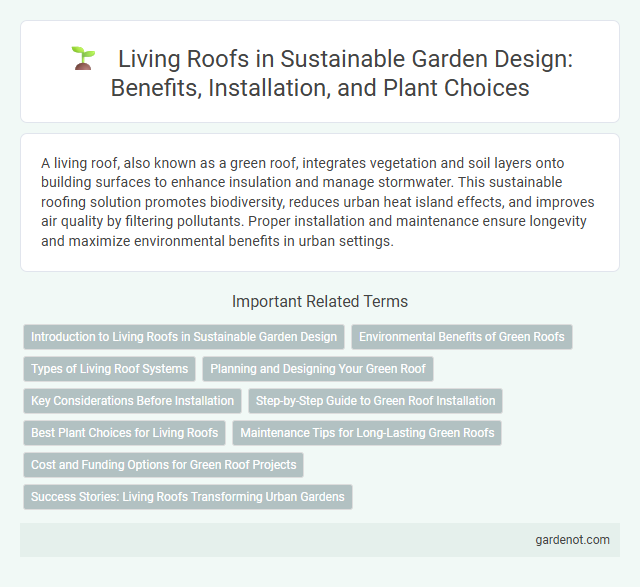A living roof, also known as a green roof, integrates vegetation and soil layers onto building surfaces to enhance insulation and manage stormwater. This sustainable roofing solution promotes biodiversity, reduces urban heat island effects, and improves air quality by filtering pollutants. Proper installation and maintenance ensure longevity and maximize environmental benefits in urban settings.
Introduction to Living Roofs in Sustainable Garden Design
Living roofs, also known as green roofs, integrate vegetation layers atop building structures to enhance urban biodiversity and improve thermal insulation. These systems contribute to sustainable garden design by reducing stormwater runoff, mitigating the urban heat island effect, and promoting air quality. Incorporating native plants and drought-resistant species optimizes ecological benefits while minimizing maintenance requirements.
Environmental Benefits of Green Roofs
Green roofs significantly reduce urban heat island effects by providing natural insulation and cooling through vegetation, which lowers surrounding air temperatures. They improve air quality by filtering pollutants and capturing airborne particulates, contributing to healthier urban environments. Enhanced stormwater management is achieved as green roofs absorb and retain rainwater, reducing runoff and alleviating strain on urban drainage systems.
Types of Living Roof Systems
Extensive living roof systems feature lightweight, low-maintenance vegetation such as sedums and grasses, ideal for residential or commercial buildings with limited structural support. Intensive living roofs support a wide variety of plants, including shrubs and small trees, requiring deeper soil layers and robust structural capacity, often serving as accessible rooftop gardens. Semi-intensive systems offer a balance with moderate soil depths and plant diversity, combining benefits of both extensive and intensive types for flexible green roofing solutions.
Planning and Designing Your Green Roof
Planning and designing your living roof involves selecting appropriate plant species that thrive in local climate conditions while ensuring the structural support can handle additional weight. Proper waterproofing, root barriers, and drainage layers are critical to prevent water damage and promote healthy plant growth. Incorporating modular trays or layered green roof systems enhances flexibility and maintenance efficiency.
Key Considerations Before Installation
Living roofs require careful evaluation of structural load capacity to support soil, vegetation, and water retention systems. Proper waterproofing and root barrier installation are essential to prevent damage to the building envelope and ensure long-term durability. Selecting appropriate plant species based on climate, maintenance availability, and local biodiversity enhances the ecological and thermal benefits of the green roof.
Step-by-Step Guide to Green Roof Installation
A living roof installation begins with assessing structural support to ensure the building can handle additional weight, followed by waterproofing and root barrier application to protect against leaks and root intrusion. Next, a drainage layer and filter fabric are installed to manage water flow and prevent soil erosion, preparing a suitable growing medium tailored to selected vegetation. Finally, drought-tolerant plants such as sedums or native grasses are planted, and ongoing maintenance includes irrigation, weeding, and monitoring for optimal plant health and system longevity.
Best Plant Choices for Living Roofs
Sedum species are the best plant choices for living roofs due to their drought tolerance, low maintenance, and ability to thrive in shallow substrates. Native grasses and wildflowers also enhance biodiversity and support pollinators while providing seasonal color variations. Incorporating a mix of succulents, sedums, and hardy perennials optimizes green roof resilience and ecological performance.
Maintenance Tips for Long-Lasting Green Roofs
Regular inspection of irrigation systems, drainage, and plant health ensures optimal conditions for living roofs. Removing invasive weeds, replenishing soil nutrients, and trimming plants prevent overgrowth and structural damage. Implementing a seasonal maintenance schedule maximizes the durability and environmental benefits of green roofs.
Cost and Funding Options for Green Roof Projects
Green roof projects typically incur initial installation costs ranging from $10 to $30 per square foot, influenced by structural requirements and plant selection. Funding options include grants from environmental organizations, government incentives such as tax credits and rebates, and partnerships with sustainability programs. Utilizing these financial resources can significantly offset expenses, making living roofs a more economically feasible choice for urban development.
Success Stories: Living Roofs Transforming Urban Gardens
Living roofs have revolutionized urban gardens by enhancing biodiversity and improving air quality in densely populated cities like Chicago and London. Projects such as the Chicago City Hall green roof demonstrate significant reductions in urban heat island effects and stormwater runoff. These living roofs not only create vibrant ecosystems but also contribute to energy efficiency and community well-being.
Living roof Infographic

 gardenot.com
gardenot.com